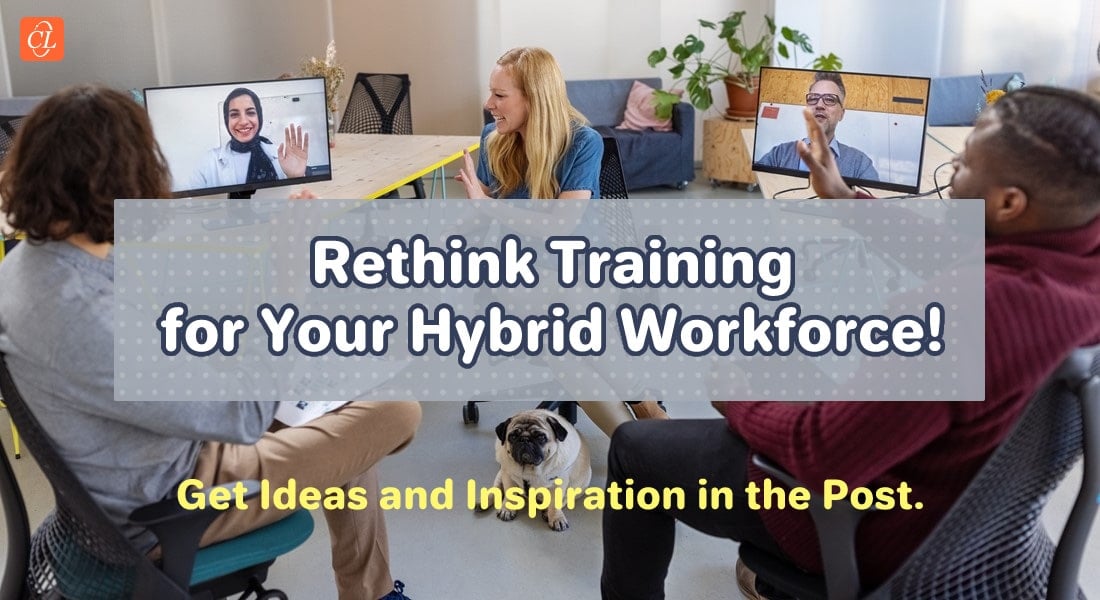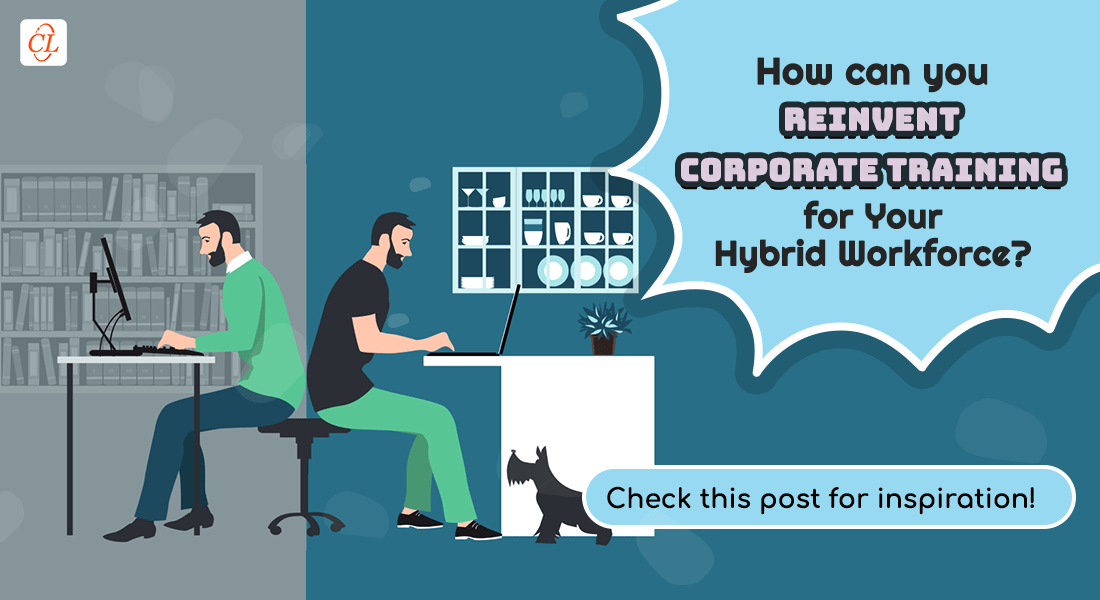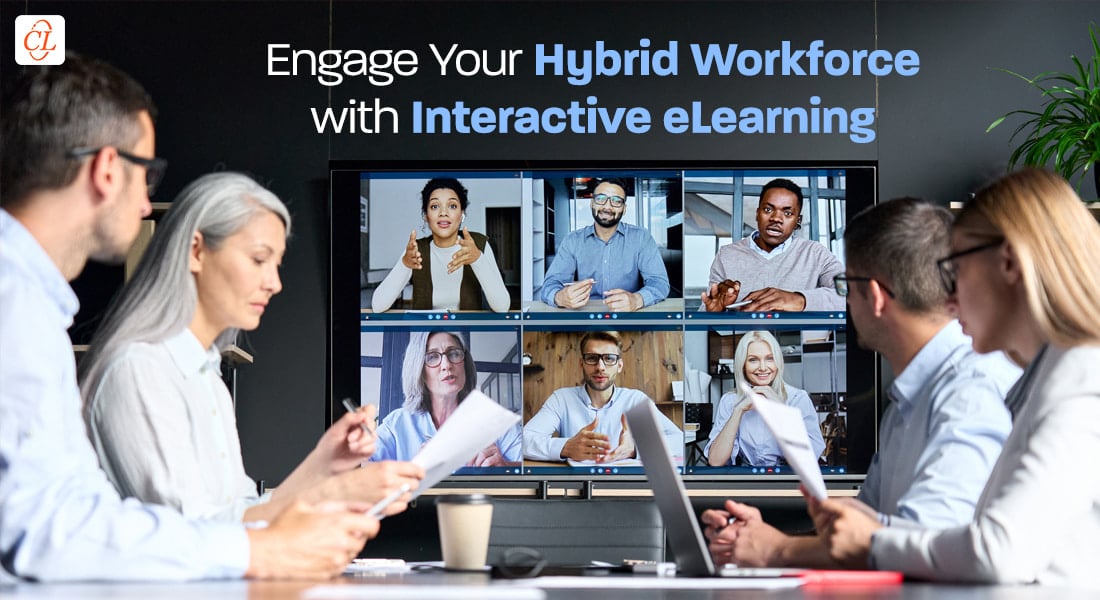Rethinking Corporate Training for Hybrid Workspaces

Teams, Zoom, Slack – endless collaborative calls combined with time spent asking, “Can you hear me?”; the world has changed since the pandemic began. From a primarily in-office work culture to being completely remote, today, we are juggling between these two structures. This has immensely impacted how corporate training is done.
A study conducted by Accenture reported that 83% of workers prefer a hybrid work model—. The hybrid model is a fine balance between maintaining the remote work culture while also having in-person office collaborations from time to time.
While this is a rising trend, implementing the hybrid work model can seem challenging. Among the most significant challenges beyond effective collaboration is implementing a well-done corporate learning strategy. A hybrid workforce calls for a blended approach to Learning and Development (L&D) activities. While eLearning is a popular resource, its effectiveness depends on “how” it is implemented rather than “where.”
If you are wondering how you can ensure effective corporate learning strategies and are new to the concept of blended learning, then you are at the right place. We make a case for why corporate learning needs a definite rethink and a transformative approach.
How to rethink learning and development for hybrid corporate workspaces?
Here are the factors to consider:
- Combat digital exhaustion
- Imbibe methods that make learning fun
- Cater to the new workforce
- Ensure learning experiences are not isolated
- Focus on communication
- Engage your learners and track success
Rethink Corporate Training, but How?
Online learning, in such cases, becomes equivalent to forced attendance at training sessions or mandatory tracking of how employees are using resources.Often, online resources become digital junk drawers. Every resource is uploaded on a shared platform with timelines to complete them irrespective of their efficacy. This excess of information can lead to overwhelmed employees with poor training results.
Understand blended learning and its effects on employee performance.
In a hybrid space, online learning takes the form of in-office sessions for employees who are currently on-site with an option for remote employees to watch them online with their presence felt through a tiny box on the screen.
This approach might seem like the obvious route to manage corporate learning, but you need to ask yourself, is it effective? Is it helping upskill your employees? If you are unsure of the answer, be assured that there is a better way.
It is crucial to modify the way learning and development takes place today and go with the flow with what works best.
There are two key factors with which you must revamp your corporate learning methods in the hybrid workspace:
- Perspective – Understand your employees needs instead of what you want them to learn.
- Empathy – Get into their shoes to understand their challenges, solutions, and shortcomings.
With these factors in mind, here are five keys to rethinking corporate training.
1. Combat Digital Exhaustion
When employees are exhausted with the amount of digital communication, corporate learning can seem like an additional burden. However, you can make this less overwhelming and more enjoyable by getting to the heart of the issue.The world has been bombarded with digital platforms in the last two years. According to a Deloitte Insights report, 40% of adults were overwhelmed with the devices and subscriptions that they had to manage while working from home.
Conduct extensive internal discussions
Include everybody in your senior management to understand their take on the organization’s goals. You will find that there is a definite need for upskilling across departments today.
According to Gartner’s research, the skills needed for a job function increases by 10% every year. Thus, updating and adding new skills to your employees is crucial.
Also, consider taking a “bottom-up” approach to understanding the training needs of your employees. Traditionally, the senior-level management dictate their employees’ skills requirements. This notion is passé. Everyone’s idea of what is essential to learning is equally important!
Listen to your employees
You could learn a lot about the usefulness of your corporate learning strategies if you listen to what your employees have to say. Conduct anonymous surveys to promote honest feedback and ask questions about what is helping them and what isn’t:
- Are they overwhelmed by the number of resources?
- Do they have enough time to achieve their training goals?
- Are the resources helping them upskill?
- Have they benefited from their learning so far?
- Which data format is most suitable?
Questions like these will give you a perspective. By spending time understanding your employees’ needs you reduce your expenditure on training data that does not help anyone.
Tip: You can use simple Google survey forms to gather data. Start in a small and simple way and see where that takes you!
2. Imbibe Methods That Make Learning Fun
Learning and Development teams are constantly looking for new ways to engage with a process. However, put your efforts in the right direction.
Ryan Roslansky, CEO of LinkedIn, once said, “The company of the future is one that embraces change, learning, and a growth mindset.”
Adapting to change and growing consistently is the way forward. The companies that understand this will flourish.
Make corporate training more user-friendly
To make it more palatable, break down an hour-long video into short 5-minute ones, which your employees can watch in their own time. This process is called “microlearning. It is essential to have a balance of asynchronous and synchronous learning materials. However, make asynchronous material (on-demand training data, such as recordings) bite-sized and easy to comprehend. Providing hours of training videos can only discourage your employees when they engage with the content.
Microlearning is a popular learning method, especially among younger generations namely the millennials and Gen Z. They do not have the same working style that was common a decade ago. Today’s generation needs quick, interesting, and engaging data that adds value to them.
A hybrid workspace for a hybrid culture
Keeping this in mind, L&D leaders can use the opportunity to turn office spaces into platforms for open discussions. Providing such a space nurtures collaborative work and encourages breakthroughs.Today, most employees no longer wish to keep working from office in the way that they once did. Almost all work is done remotely, while the office is more for collaboration.
You could achieve this by setting up co-working spaces or even transforming your existing office space. Such changes can motivate your employees to connect socially. This practice can foster bonds within teams to encourage innovative ways of achieving your organization’s goals.
Gamify corporate learning
Role-playing is an exciting opportunity to enhance your employees’ communication skills and possibly get a few laughs along the way. This method works incredibly well for customer-facing roles. If you want to train sales and customer service representatives, bring live scenarios into play and see how they work out.Corporate learning doesn’t have to be an isolated experience in front of a laptop or in a meeting room with a single speaker. You can make it more interesting to encourage employee participation and interaction.
Similarly, quizzes, dashboards, and story-based case studies are a few other exciting ways to provide gamification.
3. Cater to the New Workforce
You may have followed formal learning and development strategies and tools and achieved satisfactory results. Chances are that there will be a need for a different approach in the future if that isn’t already the case.
Don’t make distance a factor for active learning
While you are reading about hybrid models for corporate learning, a large proportion of your employees might already be working remotely. It is important to note that if you are not accommodating them or engaging them in training, they will seek out new opportunities.
94% of employees claimed that they would be willing to stay in an organization if they invested in their learning and development, as per a LinkedIn report in 2019. The hiring culture has changed so that now, the remote working model opens up possibilities and locations even though it was previously considered as a barrier.
It is also nearly impossible to ceaselessly bring everyone under the same roof. It becomes a time-consuming and expensive venture.
The Mortgage Advice Bureau (MAB) is an excellent example of this. They have around 150 partner firms consisting of approximately 1,600 advisors. To become an advisor, representatives must undergo training and gain certifications. This training course is a five-day residential program. To favor flexibility, they turned it into an on-demand training program incorporating trainer interaction.
Panapto reports that such changes have brought about an increase in new certification rates and advisor sales by 24% each, reduction in learner attrition by 12%, and decrease in costs by more than 57%.
MAB’s Training Technology Specialist Andy Cope says, “We use video analytics quite substantially to see how learners interact with our training sessions, which videos they avoid or revisit, and what information isn’t sticking.” He also said, “I particularly love being able to see what information learners are searching for and which points in a video timeline have the most engagement. This data helps us create clearer, more consistent material, improve how we communicate, and measure the success of our amendments.”
This example proves how you can assimilate a more inclusive training methodology. The digital approach saves time and money and helps engage your employees providing them with the flexibility of working remotely.
Make learning an interactive experience
A LinkedIn study on Workplace Learning shows that 67% of Gen Z employees want a more social and collaborative learning experience. The approach of forming employee silos no longer serves them. It makes for a boring learning experience with very little results.
Introduce corporate learning initiatives that encourage conversations between employees. You could include assignments that require group activities and exercises that require interaction across countries and time zones to enhance peer-to-peer communication.
Likewise, engaging your audience in a live training session while they participate virtually is equally essential. You can use tools such as Zoom that has options for employees to take part in polls, questionnaires and discussions during the meeting. Harness the power of these types of platforms to increase reciprocity from employees.
4. Ensure Learning Experiences are Not Isolated
Corporate Learning is more effective in a collaborative space. However, companies often fail to recognize the difference between how employees’ team up with their colleagues when working remotely when compared to employees in the office.
Deal with proximity bias the right way
In a hybrid workspace, employees interact from different on-site as well as remote locations. While we addressed how you could handle this using team activities, there is a chance for proximity bias to creep in. Proximity bias occurs when employees who work on-premises interact more closely with each other thereby distancing those who work remotely. This could possibly lead to groupism and unfair discrimination.
To help tackle such issues, you can implement the “buddy” system in your teams. You must ensure to keep changing who “buddies” up with who to ensure that everyone has a chance to interact with each team member.
Lean into remote work closeness
People around the globe have differing opinions about hybrid and remote workspaces. Nevertheless, whether you are for it or not, this is what most employees want. The remote work model is infamous for not fostering connections between teammates that can make for better outcomes.
Here is an interesting fact. According to the 2021 Work Index, one in five employees has interacted with their peers’ families or pets, and one in six has cried with a colleague.
The remote work model has brought out a different type of vulnerability among employees. When you encourage your employees to lean into and share their vulnerabilities instead of running away from them, under the garb of being professional, you also help foster more authentic connections as well as replicate in-person bonds. This type of bonding helps employees learn more effectively.
You can curate corporate training modules under the umbrella of peer learning that strengthen workplace relationships by helping employees encourage each other during training. Such practices also help build inclusivity and benefit people from a variety of races and ethnic groups.
5. Focus on Communication
The new hybrid workplace requires additional critical communication skills. Managers must go beyond their usual responsibilities to learn how their teammates are doing. However, a lot of them are not equipped with the required skills.
The 2021 Work Index report cited earlier also shows that 61% of employees are thriving. Employees who do not hold decision-making responsibilities have a 23% higher rate of satisfaction than those who do.. Effectively, there is a disparity between how the two groups perceive hybrid work models.
Jared Spataro, CVP at Microsoft 365, said, “Those impromptu encounters at the office help keep leaders honest. There are fewer chances to ask employees, “Hey, how are you?” and then pick up on important cues as they respond with remote work. But the data is clear: our people are struggling. And we need to find new ways to help them.”
Thus, building interpersonal skills is an important part of corporate learning that enhances the overall well-being of employees across the organization.
Communication skills training is crucial for those who are not strong in connecting with others. This type of skills training can go a long way in building employee relationships. Companies can strengthen their inclusivity by using training materials that makes room for people with learning disabilities.
6. Engage your Learners and Track Success
You have created the most interactive, engaging and exciting training modules. Now, what?
Ensuring the success of your training with consistent measurement of employee engagement even after the modules are completed is essential!
Dr. Brent Peterson breaks down the success of training into three parts. According to his study, 25% of training success depends on the learning event, 25% depends on how prepared the trainee was, and 50% alone is a result of following up with trainees and its corresponding activities.
Employers must take the initiative and not rely on employees to sustain their training. Promoting continual learning and engagement is directly proportional to successful training.
Consistent reward systems, gamifying ranking of peers, words of encouragement, and incentives for completing training modules are all great ways to track success. It is also essential to check in with your trainees to ensure that they work through their challenges.
To Sum Up
We discussed 5 key areas to focus on for learning and development. It is essential to rethink your processes and change activities that may have worked at one time to be relevant and make an impact today.
Learning and development activities are crucial to ensure that your employees are equipped with the right skill sets. It also fosters opportunities for mobility within the company. Such opportunities can significantly improve rates of retention where employees look within the organization to seek new career avenues.
Well-designed corporate learning modules show that you care about upskilling your employees while ensuring your customers are served with the best. Help your employees the right way and this will ultimately benefit you. Finding the right balance between work, training and engagement is essential in a hybrid workspace.
An organization that grows with the changing times promotes a culture of progress for their company. So, go ahead and formulate resources that improves skills, builds bonds and enhances your organization’s work culture.
Rapid eLearning is a great boon in today’s scenario to ensure undisrupted training for your hybrid workforce. Get introduced to the 4Rs of Rapid eLearning here!





